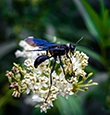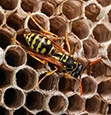Wasp and Hornet Facts & Information
Hawx is always reliable. Always innovative.
Get $350 Off Wasp and Hornet Service
20,000+ 5-STAR REVIEWS
“Connors Trader went the extra mile to make sure he listened to our needs regarding the ant problem we had.”
- Larry
“He sprayed indoors and out, swept my eaves for spider webs and took care of a couple of wasp nests.”
- Rick
“He even sprayed on my deck, which no one else has done.”
- Sue

Wasps and hornets might look intimidating buzzing around your yard, but they also play a role in nature by controlling and regulating certain insect populations. Despite their sometimes unseen benefits, nobody wants them building nests near the front door, under the eaves of a house, near the garage, or really anywhere else you frequent in and around your property.
If you’ve noticed an increase in wasp or hornet activity—or noticed a nest in an inconvenient spot—don’t panic. Below, we’ll explore how to recognize common wasp and hornet species, what draws them to your property, and practical steps you can take to keep them away so you can enjoy your property without the fear of being stung or harassed.
What’s the Difference Between Wasps & Hornets?
Although many people use “wasp” and “hornet” interchangeably, hornets are actually a type of wasp. Both have slender bodies and narrow waists, but hornets tend to be larger and often sport white or light-colored markings on their heads and abdomens. Yellow jackets, paper wasps, and bald-faced hornets are some of the most common species in the United States. Most wasps build papery nests from chewed wood pulp, though some, like yellow jackets, may also nest inside the ground.
These insects defend their nests if they feel threatened—and unlike bees, certain wasps can sting multiple times. Stings can be painful and sometimes trigger severe allergic reactions, especially for sensitive individuals. This natural defense mechanism is part of why a colony of wasps or hornets in a high-traffic area can quickly become more than just problematic for homeowners.
Why Wasps & Hornets Come Around Your Home
Wasps and hornets aren’t usually on a mission to bother humans. Instead, they’re drawn to your home and yard by food sources, shelter, and ideal nesting spots. Standing water, uncovered trash cans, and sugary substances (like soda spills or fruit left outdoors) can attract various species of wasps and hornets. Plus, insects themselves also serve as a food source for wasps, which is helpful for pest control—but less appealing when it brings a swarm closer to your living space.
Shelter is another major factor. Gaps in soffits, loose siding, and even hollow spaces in the ground can be attractive nest sites. In late summer and early fall, wasps can become more aggressive in their search for food, especially sugary substances that help sustain them as the cooler weather approaches.
Identifying Types of Wasps & Hornets
Several types of wasps and hornets are common in the US, each with unique characteristics. Here are a few:
- Bald-faced hornets are large wasps, about ¾ inch long, with black bodies and white markings on their faces.
- European hornets are large, brown wasps with yellow and orange stripes, growing up to 1.5 inches long.
- Mud dauber wasps are long and slender with a prominent, thread-like waist, varying in color from black and yellow to metallic blue.
- Paper wasps have slender bodies with black and yellow stripes, some with red markings, and are about 1 inch long.
- Yellow jackets have black and yellow stripes and are about ½ to ¾ inch long

“Wasps & hornets vary widely in how they live, what their nests look like, and how aggressive they are. If you’re not sure what type of wasp or hornet you’re dealing with, do not swat at them. Unlike some bees, they can sting multiple times, and in the case of bald-faced hornets, they have a very painful sting and they will sting you over and over. I’m just gonna say it: Bald-faced hornets are jerks. ”
Vice President of Technical & Training Services, Entomologist
Wasp & Hornet Behavior
Lifecycles of wasps & hornets
The lifecycles of wasps and hornets are quite similar. In the spring, a queen emerges from where she spent the winter and begins to build a nest. She lays her first eggs, which hatch into worker wasps. During the summer, those workers expand the nest, forage for food, and care for the young, allowing the colony to grow.
In the fall, the queen produces males and females (new queens), which then mate with each other. As cold weather approaches, the new queens will find a protected place to overwinter, while the rest of the colony dies out.
Telling Nests Apart
See something that might be a wasp nest or hornet nest? Here are some of the most common varieties:
- Paper wasps often build structures from a papery material with open cells you can see from below. They’re shaped like an open, upside-down umbrella, typically hanging under eaves or porch ceilings.
- Mud dauber wasps build nests in sheltered sites under eaves, in garages, sheds, and on protected building walls. There are three types of mud daubers:
- Black and Yellow Mud Daubers build irregularly shaped, lumpy nests made of mud
- Blue Mud Daubers don’t build nests but use abandoned nests of other mud daubers.
- Organ Pipe Mud Daubers build nests with long, smooth mud tubes placed side by side.
- Bald-faced hornets build aerial nests in trees, shrubs, or on building eaves. They tend to be large and football-shaped.
- European hornets nest in hollow trees, barns, sheds, attics, and wall voids. Their nests are large, enclosed, papery structures.
- Yellow jackets nest underground in abandoned rodent burrows or other enclosed spaces, and sometimes in wall voids, woodpiles, and dense vegetation
Rule of thumb: if you see a steady stream of wasps zipping in and out of the same hole or crevice, there’s a good chance you’ve found a nest entrance.
Practical Prevention Tips
One of the best ways to deter wasps and hornets is to remove what attracts them in the first place. Keep trash cans sealed, clean up food spills when they happen, and store sweet beverages in closed containers. Having some friends over for some patio beers? Place your empty beers and cans in a sealed trash or recycling container—don’t leave them sitting out overnight.
Fixing drips and leaks also reduces standing water where these insects might gather. Giving your yard a regular solid once-over—i.e., trimming hedges, raking leaves, and repairing loose siding—helps eliminate nesting sites. Plus, adding screens to windows, doors, and vents can go a long way toward keeping wasps out of interior spaces.
Let Hawx Handle Your Wasp & Hornet Problem
When you’re ready to reclaim your yard from the threat of stinging insects like wasps and hornets, Hawx Pest Control is ready to help. Our local experts know the ins and outs of wasp and hornet behavior, from nest construction to food preferences. We begin with a thorough inspection to pinpoint problem areas, then develop a personalized plan to remove nests and prevent future infestations. Whether it’s a single nest or multiple hotspots around your property, we use proven methods to tackle wasps and hornets at the source.
Contact Hawx Pest Control today for an assessment and customized treatment plan. With our help, you can enjoy the outdoors again—without worrying about what’s buzzing around your home.
Wasp and hornet Identification: What Are the Main Types of Household Wasp and hornets?
Wasp and hornets can vary widely from species to species, so it's important to know how to identify wasp and hornets that typically invade homes.
Read more about wasps and hornets

Most Painful Insect Stings – The Schmidt Pain Index
Did you know there’s an official pain scale for insect stings? It is called the Schmidt Pain Index for Stings. It was created by an

Wasp Woes: Managing Wasp Nests Safely in Tampa Yards
Wasp Woes: Managing Wasp Nests Safely in Tampa Yards Welcome to the sunshine state, where it’s hot, it’s humid, and the wasps are out to

Buzzing Nuisances: Dealing with Wasp Infestations in Raleigh Yards
Buzzing Nuisances: Dealing with Wasp Infestations in Raleigh Yards What’s that buzzing sound? Oh, just another wasp circling your head again? If you live in
Is your property under threat from stinging insects? Contact Hawx Pest Control today for wasp control services in your area.






